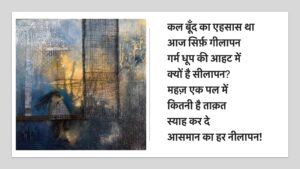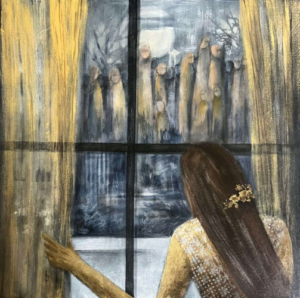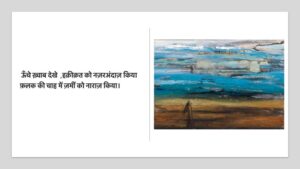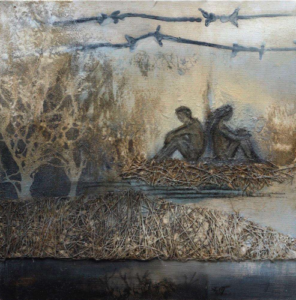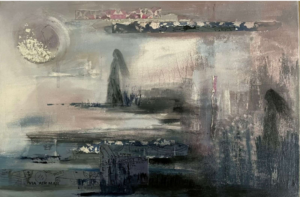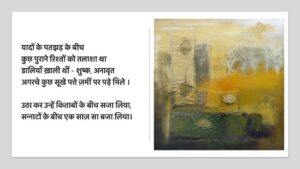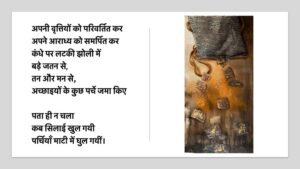A confluence of art and poetry by artists Rita Jhunjhunwala at Bikaner House

Artist Rita Jhunjhunwala
Rajkumari Sharma Tankha
Her passion for writing inspired her to curate an entire collection of paintings where. Artist Rita Jhunjhunwala is presenting 40 of her poetry works that she penned over four decades, with a painting each representing the poem, at Living Traditional Centre (LTC), Bikaner House, New Delhi from September 24-28.
Titled Bheegein Lakerein, the solo show is curated by Art Historian Dr Alka Pande, who works as an Art Consultant at the India Habitat Centre, New Delhi.
Rita Jhunjhunwala has followed varying techniques and media and used different kinds of textures like fabrics, paper, gold foil, charcoal, elements of nature, etc. to represent her poems through paintings.
In a candid conversation with Life & More, Rita Jhunjhunwala shares her life and her art. Excerpts:
How did you come up with this idea of paintings and poems? And what is it that you want to tell people through this show?
I once wrote a poem about my grandmother, whom I admired greatly, and then painted a portrait of her. Then it occurred to me, why not illustrate my other poems as well? It was a challenging and intriguing idea for me, and I thoroughly enjoyed putting it into action.
That is why I am putting up the exhibition. I hope others enjoy the poems as much as I enjoy creating it. My poems are full of emotion even though and there is no social message here, but the emotions are universal and relatable to everyone.
You first write a poem and then create a painting on it. How challenging is t?
Yes, I created the paintings after writing the poems. It was difficult, but it was also interesting for me. Because emotions are not concrete, I had to use a different style to depict them in an abstract manner on canvas, like sand, fabric, stamped paper, handmade paper, gold foil and a variety of other things. It took me two years to complete these 40 works.
This being your first physical show after the pandemic, how does it feel to be back in art galleries after two years?
Yes, this is my first solo show since the pandemic, and it’s wonderful to be back in galleries after two-years. My last exhibition was in 2020; I typically have a solo show every two years, so there wasn’t much of a gap as I was painting throughout the pandemic, except for missing out on group shows.
What’s your take on online shows, and which one do you prefer – online or physical?
Physical shows, in my opinion, perform better than online shows. Everything is different when seem physical, from the colours to the textures. But thanks to online shows during the pandemic, one wasn’t completely cut off.
In the last more than four decades since you have been painting, what kind of changes have you seen in the art world?
The art world has changed dramatically in the last few decades. Nowadays, if you go to art fairs, you almost never see pure paintings; instead, they are more experimental in nature, made with various materials and mediums, so there is a lot of experimentation and thinking outside the box, which is a good thing.
At the same time, many people pass off anything as art as it has a gimmicky value. Anything that is different is not always good art. As a result, one must exercise caution. But there is no doubt that the art world is going places.
Which is your favourite medium to paint and why?
Acrylic is my favourite medium because it is so versatile. It can be used as oil as well as watercolour, and it can be combined with any other material. It is extremely friendly to all other mediums.
40 years back the societal environment was not very conducive to artists. How was your experience (with your parents) when you evinced your interest to study art?
There were few art galleries back then, and women painted all the time. Society was not against it in my experience. My parents and my in laws were very supportive of my ambition to be an artist. Newspapers used to provide artists with ample exposure and coverage as there were few exhibitions.
When did you actually decide to become an artist? Who inspired you to become an artist?
When I was very young, in Kolkata, there would be these fairs where there was always a little corner for on-the-spot art competitions and I would normally win prizes. Then, when I was 12, I received the Soviet Land Nehru Award for my artwork from the then President. Our school was visited by the Russian ambassador to bestow the award on me. So, I became known as an artist from then on and I took it up very seriously.
Which city do you think is more conducive to artists – in India and globally?
My experience in Mumbai, India, has been very positive. There are people with different tastes and budgets which suits all the artists. Commercially, Mumbai is very viable in my opinion, but in terms of art appreciation, nothing beats the people of Kolkata. They are artistically inclined, culturally knowledgeable and appreciate art.
Globally, New York is very good in my opinion, despite the fact that I have never exhibited there in a solo show. I have had two solo shows in Paris with extremely positive responses, so Paris works for me.
How many hours do you spend with your brush and easel?
So, four to five hours is typical. However, if you are in the middle of a painting and are completely immersed in it, it could take 10 hours. Then there are days when you take a vacation or are otherwise busy, so it sometimes takes a back seat and I can only paint for two hours or so, but I try to paint every day on a regular basis.
What are your other interests?
Listening to music, reading, and travelling.
Do you have any other shows planned?
I am participating in an art show in New York, in March 2023 and for that, I have to make new paintings and I’m looking forward to that.


